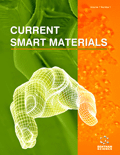Abstract
Background: Electrorheological fluids, when subjected to an external electric field, show radical and reversible changes in their physical properties: Rheological, thermal, electrical - as a result of the structuring of the dispersed phase particles. This article presents the results of experimental studies of the viscoelastic properties of high-concentrated electrorheological fluids with complex dispersed phase in a pre-yield area under shear stresses below the yield stress in different deformation modes. The components of the dispersed phase were bentonite clay and chromium phosphate or aerosil and chromium phosphate.
Objective: The objective of this work is to determine dependencies of the viscoelastic parameters of high-concentrated electrorheological fluids with complex dispersed phase on electric field strength and on dispersed phase composition in different regimes of mechanical tests, to establish general regularities of electrorheological fluids deformation in non-stationary conditions. Methods: The investigation of the rheological properties in a pre-yield area under shear stresses below the yield stress were carried out in the following shear regimes: the forced tangential sinusoidal oscillations with constant frequency, linear increase of shear stress, linear increase of normal stress (compression mode), creep mode at constant shear stress and its cessation. Results: It was found that the sample with dispersed phase based on bentonite clay and chromium phosphate shows the biggest increase in the values of the components of the complex shear modulus among the studied compositions. The most robust static structure is observed in the sample containing aerosil and chromium phosphate. Preliminary holding in electric field (5 min) leads to hardening of the structure: in creep mode and under linear increase of shear stress the deformation decreases by 2-3 times. In the compression mode fluids exhibit linear elasticity for high field strengths in the investigated range of normal strains. At lower field strengths there is weakening of the structure and nonlinear deformation development with shear strain increasing. Conclusion: Variation of the regimes of mechanical tests and of electric field strength in combination with purposefully changed composition of electrorheological fluids makes it possible to vary their mechanical behavior. This allows one to create purposefully materials that have such characteristics as rigid, elastic, viscous, plastic properties and their combinations. The experimental dependences obtained in the work allowed the offering of a generalized non-stationary rheological model of elastoviscoplastic behavior of electrorheological fluids.Keywords: Electrorheological fluids, rheological model, shear deformation, shear modulus, viscoelastic characteristics, yield stress.
 11
11





